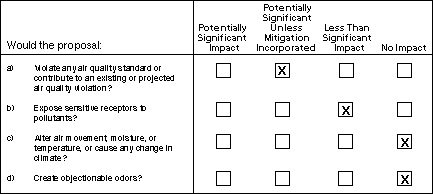
V. AIR QUALITY

Construction activities would temporarily increase particulate concentrations in and around the project sites. The substation site has been previously graded and paved so that it is essentially flat, with existing drainage. Equipment and vehicles would generate dust during excavation of the SPCC pond. Because the site is paved, construction vehicle traffic would not occur on unpaved surfaces, which generate substantial dust. Boring of pole foundation holes, however, would be a minor source of dust emissions.
It is not possible to accurately estimate the particulate concentrations that would occur at or adjacent to the construction sites because such concentrations are very sensitive to local meteorology and topography and to variations in soil, silt, and moisture content.
The Bay Area Air Quality Management District (BAAQMD) considers construction emissions to be significant only if project-appropriate mitigation measures are not implemented. Dust is comprised of large particles (i.e., larger than 10 microns in diameter) which settle out rapidly on nearby horizontal surfaces and are easily filtered by human breathing passages. Much of the dust generated by construction is, therefore, of concern more as a soiling nuisance rather than for its unhealthful impacts. The remaining fraction of small particulate matter might be sufficient to violate the state 24-hour average PM-10 standard in the vicinity of construction. Unless mitigation measures are implemented, elevated levels of PM-10 would occur throughout periods of project construction. Because residences are located immediately downwind of the project site, mitigation measures would be necessary.
The substation itself would generate no emissions. The proposed project would allow for the delivery of electricity that would otherwise not be transmitted. Much of California’s electricity is generated by burning fossil fuels, the combustion of which results in air pollutant emissions. Consequently, fuel-combustion power plants within California would increase production to deliver the electricity demand facilitated by the proposed substation. However, these emissions could be generated from any or all of the air districts within California, or even from out of state. The environmental impact of air emissions from the each power plant would be assessed at the time of power plant construction or permit issuance by the local air District. The project itself would not induce demand for generation of additional electricity.
Maintenance of the transformers would require intermittent vehicle trips to the site. Assuming 400 miles per month of light-duty truck trips and 100 miles per month of heavy-duty truck trips, maintenance-related mobile emissions would be less than 2 pounds per day of any criteria pollutant or precursor. This would be less than the BAAQMD recognized significance criteria of 80 pounds per day of reactive organic gases, oxides of nitrogen, or PM-10.
Mitigation
The following mitigation measure would reduce the potential impact of dust generation to a less-than-significant level:
Mitigation Measure V.a-1: PG&E shall require its construction contractors or crews to implement a dust abatement program during construction activities. The dust abatement program should include the following (as adapted from BAAQMD):
Water exposed soils at all active construction sites at least twice daily on days without measurable rainfall at the site;
Cover all trucks hauling soil, sand, and other loose materials or require all trucks to maintain at least two feet of freeboard;
Pave, apply water three times daily, or apply (non-toxic) soil stabilizers on all unpaved access roads, parking areas, and staging areas at construction sites; and
Sweep daily (with water sweepers) the paved access road to the substation site, and paved parking and staging areas at the substation site. Sweep each paved street area used to drill foundation holes and pour foundations for power line towers.
PG&E shall certify compliance with this measure in scheduled progress reports to the CPUC.
As discussed in the response to item V.a, construction dust emissions could have a temporary impact on nearby residences of the substation fronting on Stockton Avenue. Residences occupied by very young children or the infirm could be considered sensitive receptors. However, the impact to these residences would likely be a nuisance impact of larger particle dust settling and not an impact related to a violation of PM-10 standards. With implementation of the above-cited mitigation measure V.a-1, this impact would be less than significant. Project operations would not have a long-term impact to local air pollutant concentrations because transformers and other substation equipment are not sources of air emissions.
The proposed substation would not be a large source of thermal emissions and would not represent the type of operation that could cause alteration of air movement, moisture, or temperature, or cause any change in climate. Therefore, there would be no impacts related to climate change.
The proposed substation is not the type of operation identified by the BAAQMD as a typical odor source (BAAQMD, 1996). The project would not result in an odor-related impact.
TOP
| Forward to Next Section (Transportation and Circulation) |
Back to Previous Section (Water) |
Back to FMC Substation Main Page | PG&E Substation Projects Main Page | CPUC Home Page |